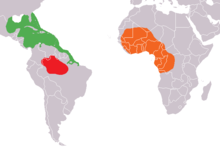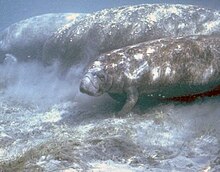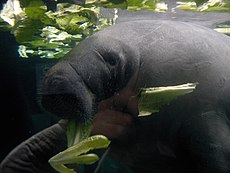Manatee
| Manatee | |
|---|---|

| |
| Antillean Manatee | |
| Scientific classification | |
| Kingdom: | |
| Phylum: | |
| Class: | |
| Order: | |
| Family: | Trichechidae Gill, 1872
|
| Genus: | Trichechus Linnaeus, 1758
|
| Species | |
|
Trichechus inunguis | |
Manatees (family Trichechidae, genus Trichechus) are large, fully aquatic, mostly herbivorous marine mammals sometimes known as sea cows. They are noted for their friendly nature, up to 4 meter size and paddle-like flippers. The name manatí comes from the Taíno, a pre-Columbian people of the Caribbean, meaning "breast".[1]
Taxonomy
Manatees comprise three of the four living species in the order Sirenia. The 4th is the Eastern Hemisphere's dugong. The Sirenia are thought to have evolved from four-legged land mammals over 60 million years ago, with the closest living relatives being the Proboscidea (elephants) and Hyracoidea (hyraxes).[2]
The Amazonian's hair color is brownish gray and they have thick, wrinkled skin, often with coarse hair, or "whiskers." The West African Manatee is the least studied of the three. Photos are rare; although very little is known about this species, scientists[who?] think they are similar to West Indian Manatees. The name in Songhay, the local language, is "ayyu".
Description
Manatees have a mean mass of 400 to 550 kilograms (880 to 1,210 lb), and mean length of 2.8 to 3 metres (9.2 to 9.8 ft), with maximums of 3.6 metres (12 ft) and 1,775 kilograms (3,913 lb) seen (the females tend to be larger and heavier). When born, baby manatees have an average mass of 30 kilograms (66 lb). They have a large flexible prehensile upper lip that acts in many ways like a shortened trunk, somewhat similar to an elephant's. They use the lip to gather food and eat, as well as using it for social interactions and communications. Manatees have shorter snouts than dugongs. Their small, widely-spaced eyes have eyelids that close in a circular manner. Manatees are believed to see in color. The adults have no incisor or canine teeth, just a set of cheek teeth, which are not clearly differentiated into molars and premolars. Uniquely among mammals, these teeth are continuously replaced throughout life, with new teeth growing at the rear as older teeth fall out from farther forward in the mouth. At any given time, a manatee typically has no more than six teeth.[3] Its tail is paddle-shaped, and is the clearest visible difference between manatees and dugongs; while a dugong tail is fluked, similar in shape to a that of a whale.[4]
Like horses, they have a simple stomach, but a large cecum, in which they can digest tough plant matter. In general, their intestines are unusually long for animals of their size.
Life history
Half a manatee's day is spent sleeping in the water, surfacing for air regularly at intervals no greater than 20 minutes. Manatees spend most of the rest grazing in shallow waters at depths of 1–2 metres (3.3–6.6 ft). The Florida subspecies (T. m. latirostris) has been known to live up to 60 years.
Swimming
On average, manatees swim at about 5 to 8 kilometres per hour (3.1 to 5.0 mph). However, they have been known to swim at up to 30 kilometres per hour (19 mph) in short bursts.
Intelligence
Manatees are capable of understanding discrimination tasks, and show signs of complex associated learning and advanced long term memory.[5] They demonstrate complex discrimination and task-learning similar to dolphins and pinnipeds in acoustic and visual studies.[6]
Reproduction
Manatees typically breed once every two years, gestation lasts about 12 months, and it takes a further 12 to 18 months to wean the calf. Only a single calf is born at a time and aside from mothers with their young or males following a receptive female, manatees are generally solitary creatures.[3]
Ecology
Range and habitat

Manatees inhabit the shallow, marshy coastal areas and rivers of the Caribbean Sea and the Gulf of Mexico (T. manatus, West Indian Manatee), the Amazon Basin (T. inunguis, Amazonian Manatee), and West Africa (T. senegalensis, West African Manatee). A fourth species, the Dwarf Manatee (T. "pygmaeus") was recently proposed for a population found in the Brazilian Amazon,[7] although some believe it to be an immature Amazon Manatee.[8]
They enjoy warmer waters and are known to congregate in shallow waters, and frequently migrate through brackish water estuaries to freshwater springs. Manatees cannot survive below 15°C (288 K; 60°F). Their natural source for warmth during winter is warm-spring fed rivers.

West Indian
The coast of Georgia is usually the northernmost range of the West Indian Manatee because their low metabolic rate does not protect them in cold water. Florida manatees can move freely between salinity extremes.
Manatees have been spotted as far north as Cape Cod, and as recently as the late summer of 2006, one made it up to New York City and Rhode Island's Narragansett Bay, as cited by The Boston Globe. According to Memphis, Tennessee's The Commercial Appeal newspaper, one manatee was spotted in the Wolf River harbor near the Mississippi River in downtown Memphis, Tennessee, on October 23, 2006, though it was later found dead ten miles downriver in McKellar Lake.[9]
The West Indian Manatee migrates into Florida rivers such as the Crystal River, the Homosassa River, and the Chassahowitzka River. The head springs of these rivers maintain a 22°C (299 K; 72°F) temperature year round. During November to March, approximately 400 West Indian Manatees (according to the National Wildlife Refuge) congregate in the rivers in Citrus County, Florida.
Manatees often congregate near power plants, which warm the waters. Some have become reliant on them and have ceased migrating to warmer waters. The U.S. Fish and Wildlife Service is trying to find a new way to heat the water for manatees that are dependent on plants that have closed. The main water treatment plant in Guyana has four manatees that keep storage canals clear of weeds; there are also some in the ponds of The National Park in Georgetown, Guyana.
Studies suggest that Florida manatees must have some access to fresh water for proper osmoregulation.
Florida manatees (T. manatus) number between 1,000 and 3,000. Accurate population estimates of the Florida manatee are notoriously difficult and have been called scientifically weak[10]; with widely varying counts from year to year, some areas show increases and others decreases, with very little strong evidence of increases except in 2 areas. Manatee counts are highly variable without an accurate way to estimate numbers:in Florida in 1996, a winter survey found 2,639 manatees; in 1997 a January survey found 2,229; and a February survey found 1,706.[6]
Population viability studies carried out in 1997 found that decreasing adult survival and eventual extinction is a probable future outcome for Florida manatees, without additional protection.[11]
Fossil remains of Florida manatee ancestors date back about 45 million years.
Amazonian
The freshwater Amazonian Manatee (T. inunguis) inhabits the Amazon River and its tributaries. Amazonian Manatees (T. inunguis) never venture into salt water.
West African
They are found in coastal marine and estuarine habitats, and in freshwater river systems along the west coast of Africa from the Senegal River south to the Kwanza River in Angola, including areas in Gambia, Liberia, Guinea-Bissau, Guinea, Sierra Leone, Côte d'Ivoire, Ghana, Mali, Nigeria, Cameroon, Gabon, Republic of the Congo, and Democratic Republic of the Congo.
They live as high upriver on the Niger River as Gao, Mali.
Communication
They emit a wide range of sounds used in communication, especially between cows and their calves. Adults communicate to maintain contact and during sexual and play behaviors. Taste and smell, in addition to sight, sound, and touch, may also be forms of communication.
Diet
Manatees are herbivores and eat over 60 different plant species such as mangrove leaves, turtle grass, and types of algae, using their divided upper lip. An adult manatee will commonly eat up to 10% of its body weight (approx 50 kg) per day. Manatees have been known to eat small amounts of fish from nets.[12]
Predation
Manatees have few natural predators (sharks, crocodiles, orcas, and alligators.) Predation does not present a significant threat to their survival.
Relation to humans


Threats
Human activity represents an existential threat to all three manatee species.
Florida manatee deaths caused by humans have increased through the years, and now typically account for 20%-40% of recorded deaths.[13] There were 417 manatee deaths in 2006 with 101 attributed to human causes according to the Florida Fish and Wildlife Conservation Commission.
Ship strikes
Their slow-moving, curious nature, coupled with dense coastal development, has led to many violent collisions with propellers from fast moving recreational motor boats, leading frequently to maiming, disfigurement, and even death. As a result, a large proportion of manatees exhibit propeller scars on their backs. They are now even identified by humans based on their scar patterns. Some are concerned that the current situation is inhumane, with upwards of 50 scars and disfigurements from boat strikes on a single manatee.[6][14] Often the cuts lead to infections, which can prove fatal. Internal injuries stemming from hull impacts have also been fatal.
Manatees hear on a higher frequency than what would be expected for such large marine mammals. Many large boats emit very low frequencies which confuse the manatee and explain their lack of awareness around boats. National Geographic has done experiments proving that when a boat has a higher frequency the manatees rapidly swim away from danger.[15]
In 2003, a population model was released by the U.S. Geological Survey that predicted an extremely grave situation confronting the manatee in both the Southwest and Atlantic regions where the vast majority of manatees are found. It states,
- “In the absence of any new management action, that is, if boat mortality rates continue to increase at the rates observed since 1992, the situation in the Atlantic and Southwest regions is dire, with no chance of meeting recovery criteria within 100 years.”[16]
A 2007 University of Florida study found that more than half of boat drivers in Volusia County, Florida, sped through marked conservation zones despite their professed support for the endangered animals. Little difference was found among the ski boats, pontoons, and fishing vessels. In the study, 84 percent of the 236 people who responded claimed to obey speed limits in manatee zones during their most recent boating experience, but observers found that only 45 percent actually complied.
- "Hurricanes, cold stress, red tide poisoning and a variety of other maladies threaten manatees, but by far their greatest danger is from watercraft strikes, which account for about a quarter of Florida manatee deaths," said study curator John Jett.[17]
The current main threat in the United States is being struck by boats or slashed by propellers. Sometimes manatees can live through strikes, and over fifty deep slashes and permanent scars have been observed on some manatees off the Florida coast.[6] However, the wounds are often fatal, and the lungs may even pop out through the chest cavity.[6]
According to marine mammal veterinarians:
- "The severity of mutilations for some of these individuals can be astounding - including long term survivors with completely severed tails, major tail mutilations, and multiple disfiguring dorsal lacerations. These injuries not only cause gruesome wounds, but may also impact population processes by reducing calf production (and survival) in wounded females - observations also speak to the likely pain and suffering endured".[6] In an example, they cited one case study of a small calf "with a severe dorsal mutilation trailing a decomposing piece of dermis and muscle as it continued to accompany and nurse from its mother...by age 2 its dorsum was grossly deformed and included a large protruding rib fragment visible."[6]
These veterinarians go on to state:
- "the overwhelming documentation of gruesome wounding of manatees leaves no room for denial. Minimization of this injury is explicit in the Recovery Plan, several state statutes, and federal laws, and implicit in our society's ethical and moral standards."[6]
Manatees occasionally ingest fishing gear (hooks, metal weights, etc.) while feeding. These foreign materials do not appear to harm manatees, except for monofilament line or string, which can clog its digestive system and slowly kill it.
Manatees can also be crushed in water control structures (navigation locks, floodgates, etc.), drown in pipes and culverts, and are occasionally killed by entanglement in fishing gear, primarily crab pot float lines. Manatees are also vulnerable to red tides—blooms of algae, often caused by pollution, which leaches oxygen from the water.
While humans are allowed to swim with manatees in one area of Florida,[18] there have been numerous charges of people harassing and disturbing the manatees. The law permitting swimming with wild manatees may be soon repealed.[19]
African manatee's only significant threats are due to poaching, habitat loss, and other environmental impacts.[citation needed] They occasionally get stranded as the river dries up at the end of rainy season and are cooked for a meal.
Conservation
All three species of manatee are listed by the World Conservation Union as vulnerable to extinction.
It is illegal under federal and Florida law to injure or harm a manatee.[6] On June 8, 2006, The Florida Fish and Wildlife Conservation Commission voted to downgrade its status to "threatened" in that state.[20] While none of the state laws protecting manatees have changed, many wildlife conservationists are not pleased with the decision. Manatees remain classified as "endangered" at the federal level.
The MV Freedom Star and MV Liberty Star, ships used by NASA to tow Space Shuttle Solid Rocket Boosters back to Kennedy Space Center, are propelled only by water jets to protect the endangered manatee population that inhabits regions of the Banana River where the ships are based.
Brazil outlawed hunting in 1973 in an effort to preserve the species. Deaths by boat strikes are still common.
Hunting

Manatees were traditionally hunted by indigenous Caribbean people. When Christopher Columbus arrived in the region, hunting was already an established trade, although this is less common today.[21]
The primary hunting method was for the hunter to approach in a dugout canoe, offering bait to attract it close enough to temporarily stunning it with a blow near the head from an oar-like pole. Many times the creature would flip over, leaving it vulnerable to further attacks.
Native Americans made war shields, canoes, and shoes, though the manatee was predominantly hunted for its abundant meat.
Later, manatees were hunted for their bones, which were used to make "special potions." Up until the 1800s, museums paid as much as $100 for bones or hides. Though hunting was banned in 1893, poaching continues today.
Captivity

The oldest manatee in captivity is Snooty who is held at the South Florida Museum. He was born at the Miami Seaquarium on July 21, 1948, and came to the South Florida Museum in Bradenton, Florida, in 1949.
Manatees can also be viewed in a number of European zoos, such as the Tierpark in Berlin, the Nuremberg Zoo, and in Beaval Park Zoo in France.
They are also included within the new plans for a National Wildlife Conservation Park in Bristol, England which is due to open in 2010 with the manatees as an addition in 2015.
Culture
The manatee has been linked to folklore on mermaids. Native Americans ground the bones to treat asthma and earache. In West African folklore, they were sacred and thought to have been once human. Killing one was taboo and required penance.[22]
Notes
- ^ http://nationalzoo.si.edu/Animals/Whats_in_a_name/default.cfm?id=37
- ^ Domning, D.P., 1994, Paleontology and evolution of sirenians: Status of knowledge and research needs, in Proceeding of the 1st International Manatee and Dugong Research Conference, Gainesville, Florida, 1-5)
- ^ a b Best, Robin (1984). Macdonald, D. (ed.). The Encyclopedia of Mammals. New York: Facts on File. pp. 292–298. ISBN 0-87196-871-1.
- ^ http://www.geocities.com/athens/acropolis/2569/animal.htm
- ^ Gerstein, E.R., 1994, The manatee mind: Discrimination training for sensory perception testing of West Indian manatees (Trichechus manatus), Mar. Mammals, 1: 10-21.)
- ^ a b c d e f g h i (Marine Mammal Medicine, 2001, Leslie Dierauf & Frances Gulland, CRC Press)
- ^ van Roosmalen, Marc G.H., Pim van Hoft, and Hans H. van Iongh. "New Species: Dwarf Manatee".
{{cite web}}: CS1 maint: multiple names: authors list (link) - ^ Trials of a Primatologist. - smithsonianmag.com. Accessed March 15, 2008.
- ^ Manatee's corpse recovered; goes to zoo for analysis, by Tom Charlier, The Commercial Appeal, December 13, 2006 (accessed December 14, 2006)[dead link]
- ^ (U.S. Marine Mammal Commission 1999)
- ^ (Marmontel, Humphrey, O'Shea 1997, Population Variability Analysis of the Florida Manatee, 1976-1992, Conserv. biol., 11: 467-481)
- ^ Powell, James (1978). "Evidence for carnivory in manatee (Trichechus manatus)". Journal of Mammalogy. 59 (2): 442. doi:10.2307/1379938.
- ^ Yearly Mortality Summaries
- ^ Florida boaters killing endangered manatees
- ^ Manatees hard of hearing
- ^ Long Term Prospects for Manatee Recovery Look Grim, According To New Data Released By Federal Government
- ^ Most boaters speed through manatee conservation zones
- ^ Savethemanatee.org - Help End Manatee Harassment in Citrus County, Florida!
- ^ St. Petersburg Times - Manatee Abuse Caught on Tape
- ^ FWC Manatee Program
- ^ Hunting for Manatees
- ^ Cooper, JC (1992). Symbolic and Mythological Animals. London: Aquarian Press. p. 157. ISBN 1-85538-118-4.
References
- Shoshani, J. (2005). Wilson, D.E.; Reeder, D.M. (eds.). Mammal Species of the World: A Taxonomic and Geographic Reference (3rd ed.). Johns Hopkins University Press. p. 93. ISBN 978-0-8018-8221-0. OCLC 62265494.
External links
- Save the Manatee Club is a Charitable organization founded by singer/song writer Jimmy Buffett in 1981 leading worldwide efforts to protect manatees and manatee habitat
- Florida Fish and Wildlife Conservation Commission
- Reuters: Florida manatees may lose endangered status
- A website with many manatee photos
- A coalition of scientists studying and saving manatees around the world
- USGS gallery on manatees
- Report on Florida manatees by primary school students
